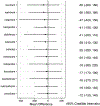Comparative efficacy of non-steroidal anti-inflammatory drugs in ankylosing spondylitis: a Bayesian network meta-analysis of clinical trials
- PMID: 26248636
- PMCID: PMC11034804
- DOI: 10.1136/annrheumdis-2015-207677
Comparative efficacy of non-steroidal anti-inflammatory drugs in ankylosing spondylitis: a Bayesian network meta-analysis of clinical trials
Abstract
Objective: To compare the efficacy of 20 non-steroidal anti-inflammatory drugs (NSAIDs) in the short-term treatment of ankylosing spondylitis (AS).
Methods: We performed a systematic literature review of randomised controlled trials of NSAIDs in patients with active AS. We included trials that reported efficacy at 2-12 weeks. Efficacy outcomes were the change in pain score and change in the duration of morning stiffness. We also examined the number of adverse events. We used Bayesian network meta-analysis to compare effects directly and indirectly between drugs.
Results: We included 26 trials (66 treatment arms) of 20 NSAIDs with 3410 participants in the network meta-analysis. Fifty-eight per cent of trials had fewer than 50 participants. All 20 NSAIDs reduced pain more than placebo (standardised mean difference ranging from -0.65 to -2.2), with 15 NSAIDs significantly better than placebo. Etoricoxib was superior to celecoxib, ketoprofen and tenoxicam in pain reduction, but no other interdrug comparisons were significant. There were no significant differences among NSAIDs in decreases in the duration of morning stiffness or the likelihood of adverse events. Adverse events were uncommon in these short-term studies. In 16 trials that used NSAIDs at full doses, etoricoxib was superior to all but two other NSAIDs in pain reduction.
Conclusions: Etoricoxib was more effective in reducing pain in AS than some other NSAIDs, but there was otherwise insufficient evidence to conclude that any particular NSAID was more effective in the treatment of AS. Comparisons were limited by small studies.
Keywords: Ankylosing Spondylitis; NSAIDs; Spondyloarthritis.
Published by the BMJ Publishing Group Limited. For permission to use (where not already granted under a licence) please go to http://www.bmj.com/company/products-services/rights-and-licensing/
Conflict of interest statement
Figures





Similar articles
-
Cost effectiveness of etoricoxib versus celecoxib and non-selective NSAIDS in the treatment of ankylosing spondylitis.Pharmacoeconomics. 2010;28(4):323-44. doi: 10.2165/11314690-000000000-00000. Pharmacoeconomics. 2010. PMID: 20222755
-
Etoricoxib and the treatment of ankylosing spondylitis.Expert Opin Drug Metab Toxicol. 2012 Dec;8(12):1599-608. doi: 10.1517/17425255.2012.741120. Epub 2012 Nov 6. Expert Opin Drug Metab Toxicol. 2012. PMID: 23126318 Review.
-
Use of gastroprotective agents and discontinuations due to dyspepsia with the selective cyclooxygenase-2 inhibitor etoricoxib compared with non-selective NSAIDs.Curr Med Res Opin. 2004 Dec;20(12):1899-908. doi: 10.1185/030079904X12681. Curr Med Res Opin. 2004. PMID: 15701208
-
Safety of Etoricoxib, Celecoxib, and Nonselective Nonsteroidal Antiinflammatory Drugs in Ankylosing Spondylitis and Other Spondyloarthritis Patients: A Swedish National Population-Based Cohort Study.Arthritis Care Res (Hoboken). 2015 Aug;67(8):1137-49. doi: 10.1002/acr.22555. Arthritis Care Res (Hoboken). 2015. PMID: 25623277
-
Etoricoxib: a review of its use in the symptomatic treatment of osteoarthritis, rheumatoid arthritis, ankylosing spondylitis and acute gouty arthritis.Drugs. 2009 Jul 30;69(11):1513-32. doi: 10.2165/00003495-200969110-00008. Drugs. 2009. PMID: 19634927 Review.
Cited by
-
Ankylosing spondylitis disease activity score is related to NSAID use, especially in patients treated with TNF-α inhibitors.PLoS One. 2018 Apr 24;13(4):e0196281. doi: 10.1371/journal.pone.0196281. eCollection 2018. PLoS One. 2018. PMID: 29689112 Free PMC article.
-
Therapies of Early, Advanced, and Late Onset Forms of Axial Spondyloarthritis, and the Need for Treat to Target Strategies.Curr Rheumatol Rep. 2017 Feb;19(2):8. doi: 10.1007/s11926-017-0633-0. Curr Rheumatol Rep. 2017. PMID: 28197884 Review.
-
Use of Immunotherapy With Programmed Cell Death 1 vs Programmed Cell Death Ligand 1 Inhibitors in Patients With Cancer: A Systematic Review and Meta-analysis.JAMA Oncol. 2020 Mar 1;6(3):375-384. doi: 10.1001/jamaoncol.2019.5367. JAMA Oncol. 2020. PMID: 31876895 Free PMC article.
-
[Long version on the S3 guidelines for axial spondyloarthritis including Bechterew's disease and early forms, Update 2019 : Evidence-based guidelines of the German Society for Rheumatology (DGRh) and participating medical scientific specialist societies and other organizations].Z Rheumatol. 2019 Dec;78(Suppl 1):3-64. doi: 10.1007/s00393-019-0670-3. Z Rheumatol. 2019. PMID: 31784900 German. No abstract available.
-
Effects of a low-dose IL-2 treatment in HLA-B27 transgenic rat model of spondyloarthritis.Arthritis Res Ther. 2021 Jul 16;23(1):193. doi: 10.1186/s13075-021-02559-y. Arthritis Res Ther. 2021. PMID: 34271972 Free PMC article.
References
-
- Song IH, Poddubnyy DA, Rudwaleit M, et al. Benefits and risks of ankylosing spondylitis treatment with nonsteroidal antiinflammatory drugs. Arthritis Rheum 2008;58:929–38. - PubMed
-
- Amor B, Dougados M, Khan MA. Management of refractory ankylosing spondylitis and related spondyloarthropathies. Rheumatic Dis Clin North Am 1995;21:117–28. - PubMed
-
- Ward MM, Kuzis S. Treatments used by patients with ankylosing spondylitis comparison with the treatment preferences of rheumatologists. J Clin Rheumatol 1999;5:1–8. - PubMed
-
- Calin A, Elswood J. A prospective nationwide cross-sectional study of NSAID usage in 1331 patients with ankylosing spondylitis. J Rheumatol 1990;17:801–3. - PubMed
-
- van der Heijde D, Baraf HS, Ramos-Remus C, et al. Evaluation of the efficacy of etoricoxib in ankylosing spondylitis: results of a fifty-two-week, randomized, controlled study. Arthritis Rheum 2005;52:1205–15. - PubMed
Publication types
MeSH terms
Substances
Grants and funding
LinkOut - more resources
Full Text Sources
Medical
Research Materials

